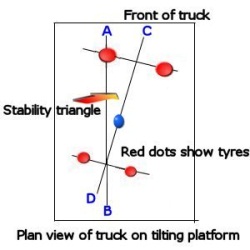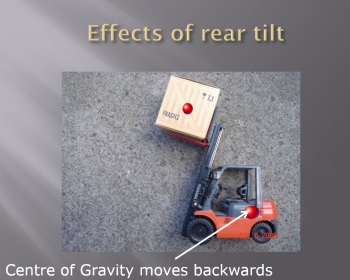Complete Powerpoint slide presentation for forklift instructors. Ready made training course
forklift stability triangle and test procedure
 Testing the forklift for sideways or lateral stability is more complex than the test for longitudinal stability. The truck has to carry its maximum rated load which is fastened to the forks as it is with all of the tests. The truck is positioned in a rather strange way on the tilting platform and a diagrammatic representation of this is shown here.
Testing the forklift for sideways or lateral stability is more complex than the test for longitudinal stability. The truck has to carry its maximum rated load which is fastened to the forks as it is with all of the tests. The truck is positioned in a rather strange way on the tilting platform and a diagrammatic representation of this is shown here.
Imagine that the centre line of the truck, looking down on the top, is represented by the line C/D.
The small red circles indicate the point where the rear wheels intersect the rear axle and the larger red circles do the same for the front.
This part is a little difficult to explain but here goes! The truck is twisted until an imaginary line, (shown here as A/B), is parallel to the hinge about which the platform is going to tip. A triangle has been created and this is known as the forklift stability triangle not surprisingly. To be exact, it's half of the truck's stability triangle.
After this has been done, the rear steering wheels are turned so that they also are parallel to the platform hinge. This has the effect of 'penalising' a four wheeled truck and makes it behave in a similar fashion to a three wheeler. The point is that three wheel trucks are just as safe as four wheel machines when properly used!
 As stated above, the truck is laden with it's design load and the mast is now elevated to maximum design height. The important difference on this test compared to the forward stability test, is that the mast must be on full rear tilt during testing. This has the effect of moving the combined (known as composite) centre of gravity towards the rear of the truck. (This is illustrated on the right.) Whilst this is happening, the combined centre of gravity moves rearwards along the line C/D. As it moves down the forklift stability triangle it gets closer to the left hand edge where the platform hinge is. This centre of gravity is indicated by the blue spot in the drawing above and the red dot in the picture on the left.
As stated above, the truck is laden with it's design load and the mast is now elevated to maximum design height. The important difference on this test compared to the forward stability test, is that the mast must be on full rear tilt during testing. This has the effect of moving the combined (known as composite) centre of gravity towards the rear of the truck. (This is illustrated on the right.) Whilst this is happening, the combined centre of gravity moves rearwards along the line C/D. As it moves down the forklift stability triangle it gets closer to the left hand edge where the platform hinge is. This centre of gravity is indicated by the blue spot in the drawing above and the red dot in the picture on the left.
Now for the test: The platform is tilted towards the hinge to an angle of 3 degrees and 27 minutes causing the blue dot to move to the left. If it ever crosses the line A/B the truck will fall over.
If a truck fails this test sometimes it can be made to pass by reducing the amount of rear tilt which moves the centre of gravity further forward. This is why for example, reach trucks only have a limited amount of rear tilt.
On a IC engine truck it is possible to fit dual wheels on the front which effectively makes the stability triangle bigger.
If all of these tricks fail it is necessary for the manufacturer to de rate the truck and that de rated capacity will be shown on the capacity plate.